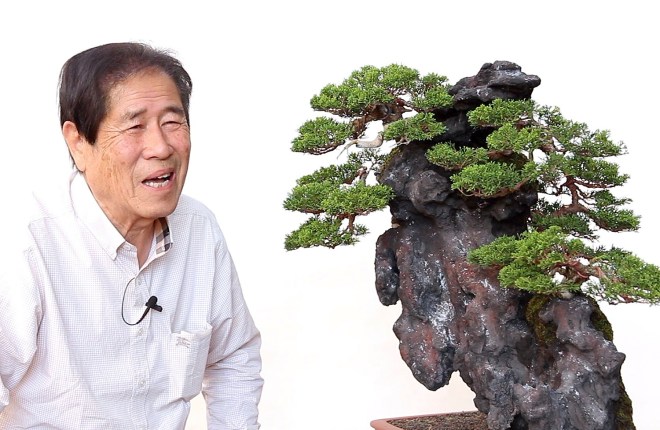Kimura Masterclass Now Available!

Bonsai Empire by Oscar Jonker has done it again! He has produced another stellar educational and entertaining online bonsai course taught by Masahiko Kimura, the magical technician of contemporary bonsai. This is the first time Mr. Kimura has presented an online bonsai course. I first had the pleasure of meeting Mr. Kimura with Chase Rosade nearly 40 years ago in his bonsai garden filled with masterpiece bonsai. Since that time International BONSAI has featured “Magic Moments- The Artistry of Kimura” a photo essay by Masahiko Kimura for over 35 years. For the past 32 issues we have published “Masahiko Kimura’s Fun Bonsai Classroom where Mr. Kimura shows how he transforms ordinary plant material into stunning works of art.

Mr. Kimura’s private classroom has been opened for his online students
So, I’m quite familiar with this innovator of contemporary bonsai and have watched dozens of his live demonstrations throughout the United States and the world. Twice a year he has opened and shared his garden for my bonsai tour members in Japan.

It’s a wonder how Bonsai Empire was able to capture the essence of Mr. Kimura’s art and techniques in the easy to learn Kimura Masterclass. Like other of Bonsai Empire’s online bonsai courses, this unique course is well organized, photographed and edited to make students easy to learn from the teacher. Masahiko Kimura shares a lifetime of cultivated knowledge through his excellent explanation of this design theory and bonsai techniques he has perfected. The photography was superb showing all details of the techniques. And, there were a few segments of high speed wiring to avoid students being bored.
The four hour bonsai course is divided into three sections which are complete close up views of two demonstrations, plus a bonus content. The first demonstration on an old collected Japanese five-needle pine shows how Mr. Kimura studies the untrained tree and how he prepares the tree for creating into a stunning windswept bonsai. For the first time I learned that Mr. Kimura dyes his raffia close to the color of the tree’s bark to make it “disappear.” Considerable time was spent with his apprentices cleaning the overgrown moss groundcover to show the hidden surface root display. The next two parts of this demonstration shows how he selects the proper gauge of annealed copper wire and how he applies it, cutting the wire to the “exact” size to avoid any waste. Clearly he has done this before. Bending techniques for heavy branches are featured as well as the proper use of guy wires. He explains his thought process of establishing the basic design according to his taste which is the cumulation of decades of study.

Before concluding the new windswept bonsai demonstration Mr. Kimura talks about refining the design and the apex silhouette aesthetics. The finished bonsai is typical of the fine quality work of Masahiko Kimura.

The second demonstration lesson shows how Mr. Kimura creates a clinging-to-a rock planting bonsai using Sargent junipers. He purchased about 50 trees and carefully selected the best six or seven trees for the rock planting composition. Mr. Kimura has been creating numerous clinging-to-a rock planting bonsai and has perfected his techniques to show nature in miniature. He was greatly influenced by his many trips to see mountains in China.

The rock for his rock planting was carved by Mr. Kimura, and although he talks about how he carved and painted the stone I wish photos or a short video on how he created the stone was shown. He wired and planted the stone to the container before planting. Each of the trees was prewired and skillfully planted on the stone. The wires for attaching the trees to the stones used an interesting technique I’ve never seen before. The asymmetrical balance of tree positioning was well done and explained. Considerable time was spent on applying the peat muck and subsequent moss. The finished rock planting bonsai looked established, like it had been created decades before.


The third or Bonus Content will be an eye opener for most students. Mr. Kimura takes a tour through his back area where his unfinished compositions and client’s bonsai are kept and trained. Many future masterpieces can be seen in this section. After the private area tour students are shown the public garden where world-famous bonsai masterpieces can be enjoyed and studied.
Finally to conclude the private lesson an interview with Mr. Kimura explains how his creativity was influenced and how he developed many of his masterwork bonsai. A great conclusion to a stimulating private lesson with Mr. Kimura. It was wonderful to hear Mr. Kimura’s advice to his students and apprentices that you should grow your bonsai with love and affection, the most important factor for bonsai. This Kimura Masterclass is really special because he has no intention to travel to teach bonsai. In Mr. Kimura’s own words about the reason for his first online bonsai course: “to share his knowledge and legacy on.”

Clearly photographed the entire online Kimura Masterclass features Mr. Kimura explaining everything in Japanese. However, Makiko Kobayashi did an excellent job translating all his comments in proper English subtitles. This must have taken considerable work to get all the fine details translated then edited and printed at the bottom of the video.
I suggest the Kimura Masterclass to any serious bonsai enthusiast who wants to learn techniques and aesthetics directly from the master to improve their bonsai skills and understanding.

As an extra added bonus, at the conclusion of my four hour private lesson I was able to print out a Certificate of Completion which can be framed and displayed. Well done Mr. Kimura, Oscar and Makiko!
Kimura Masterclass
4 hours of private instruction
$79.99
Students can easily enroll in the 4 hour Kimura Masterclass at:
https://www.bonsaiempire.com/courses/kimura-masterclass





























































You must be logged in to post a comment.